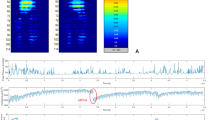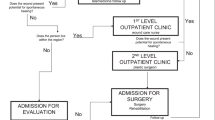Abstract
Patients with spinal cord injuries (SCI) admitted to the Institut Guttmann, Barcelona, from the years 1985 to 1988 with pressure sores (PS) are reviewed.
Demographic, pathological and psychological factors are analysed in an attempt to identify organic and/or behavioural patterns which might imply an added risk for the development of pressure sores in the spinal cord injured.
About 30% of 884 SCI patients admitted during this period had one or more PS (mean 1.5), most of these were localised to the ischial, trochanteric and sacral regions, and about 70% were grade 3 or 4 (Enis and Sarmiento classification).
The study supports the generally acknowledged view that a precarious state of health and certain psycho-social conditions are contributing factors to a higher risk in the development and severity of PS in SCI patients.
Similar content being viewed by others
Log in or create a free account to read this content
Gain free access to this article, as well as selected content from this journal and more on nature.com
or
References
Enis J E, Sarmiento A 1973 The pathophysiology and management of pressure sores. Orthopaedic Review 11: 10–25.
Nuseibeh I M 1979 The Surgical Treatment of pressures sores in spinal injuries. Paraplegia 17: 409–413.
Richardson R R 1981 Prevalence and incidence of pressure sores in acute spinal cord injuries. Paraplegia 19: 235–247.
Shand J E G 1979 Recent advances in the treatment of pressure sores. Paraplegia 17: 400–406.
Stover S L 1986 Spinal cord injury: the facts and figures. University of Alabama at Birmingham.
Wharton G W 1987 Pressure sore profile: Cost and management. Thirteenth annual scientific meeting ASIA, 115–119.
Young J S 1982 Spinal cord injury statistics. Good Samaritan Medical Center Phoenix, Arizona.
Author information
Authors and Affiliations
Rights and permissions
About this article
Cite this article
Vidal, J., Sarrias, M. An analysis of the diverse factors concerned with the development of pressure sores in spinal cord injured patients. Spinal Cord 29, 261–267 (1991). https://doi.org/10.1038/sc.1991.37
Issue date:
DOI: https://doi.org/10.1038/sc.1991.37
Keywords
This article is cited by
-
Estimation of a recurrent event gap time distribution: an application to morbidity outcomes following lower extremity fracture in Veterans with spinal cord injury
Health Services and Outcomes Research Methodology (2015)
-
Theory of Planned Behaviour, Skin Care and Pressure Sores Following Spinal Cord Injury
Journal of Clinical Psychology in Medical Settings (2006)



